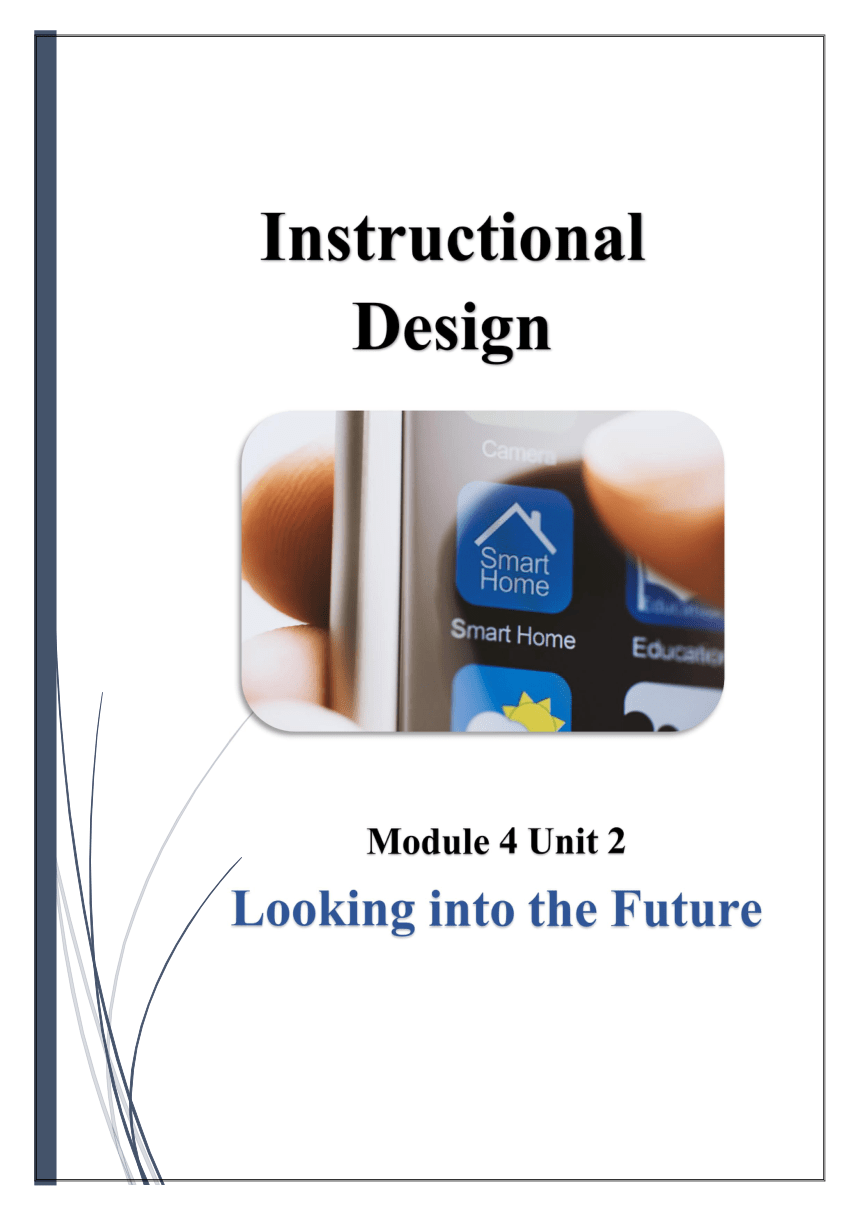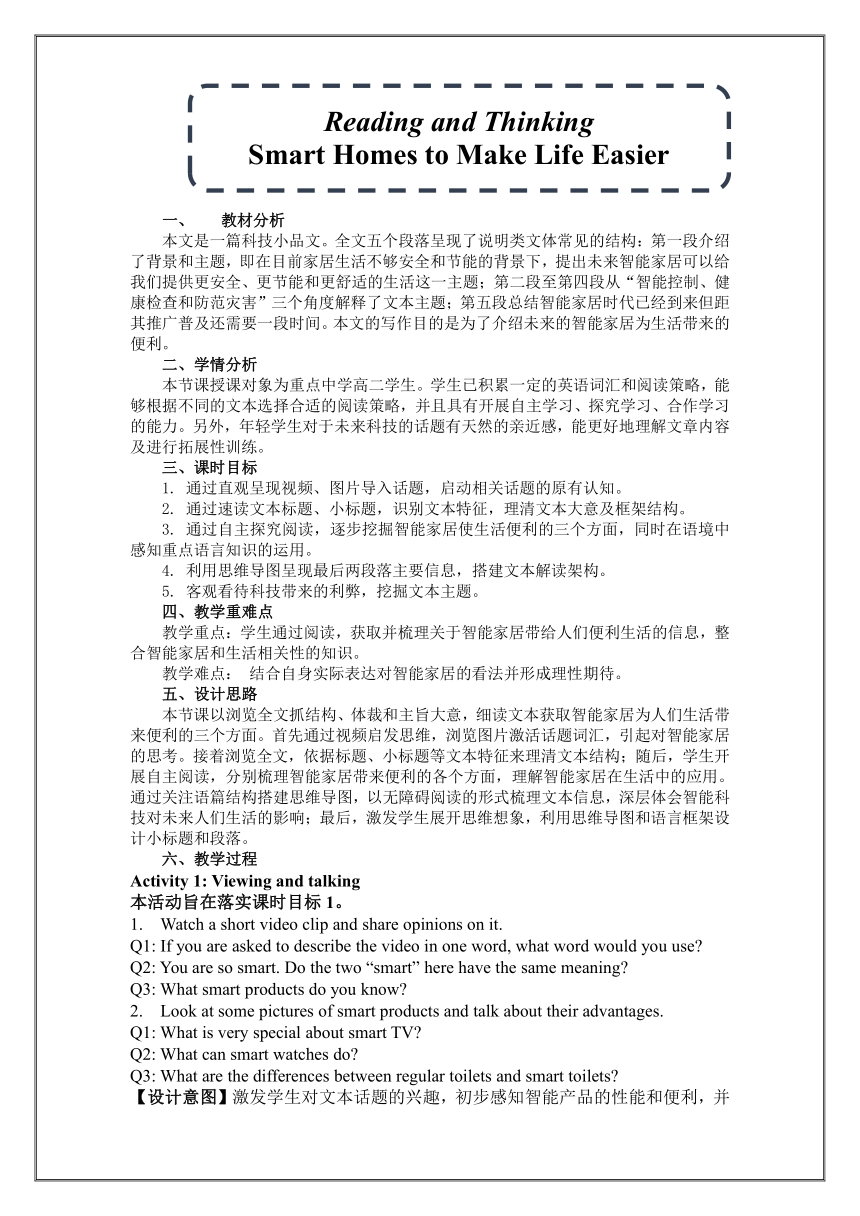人教版(2019)选择性必修第一册 Unit 2 Looking into the Future Reading and Thinking 教学设计
文档属性
| 名称 | 人教版(2019)选择性必修第一册 Unit 2 Looking into the Future Reading and Thinking 教学设计 |  | |
| 格式 | docx | ||
| 文件大小 | 926.2KB | ||
| 资源类型 | 教案 | ||
| 版本资源 | 人教版(2019) | ||
| 科目 | 英语 | ||
| 更新时间 | 2023-07-23 22:22:56 | ||
图片预览


文档简介
Reading and Thinking
Smart Homes to Make Life Easier
教材分析
本文是一篇科技小品文。全文五个段落呈现了说明类文体常见的结构:第一段介绍了背景和主题,即在目前家居生活不够安全和节能的背景下,提出未来智能家居可以给我们提供更安全、更节能和更舒适的生活这一主题;第二段至第四段从“智能控制、健康检查和防范灾害”三个角度解释了文本主题;第五段总结智能家居时代已经到来但距其推广普及还需要一段时间。本文的写作目的是为了介绍未来的智能家居为生活带来的便利。
二、学情分析
本节课授课对象为重点中学高二学生。学生已积累一定的英语词汇和阅读策略,能够根据不同的文本选择合适的阅读策略,并且具有开展自主学习、探究学习、合作学习的能力。另外,年轻学生对于未来科技的话题有天然的亲近感,能更好地理解文章内容及进行拓展性训练。
三、课时目标
1. 通过直观呈现视频、图片导入话题,启动相关话题的原有认知。
2. 通过速读文本标题、小标题,识别文本特征,理清文本大意及框架结构。
3. 通过自主探究阅读,逐步挖掘智能家居使生活便利的三个方面,同时在语境中感知重点语言知识的运用。
4. 利用思维导图呈现最后两段落主要信息,搭建文本解读架构。
5. 客观看待科技带来的利弊,挖掘文本主题。
四、教学重难点
教学重点:学生通过阅读,获取并梳理关于智能家居带给人们便利生活的信息,整合智能家居和生活相关性的知识。
教学难点: 结合自身实际表达对智能家居的看法并形成理性期待。
五、设计思路
本节课以浏览全文抓结构、体裁和主旨大意,细读文本获取智能家居为人们生活带来便利的三个方面。首先通过视频启发思维,浏览图片激活话题词汇,引起对智能家居的思考。接着浏览全文,依据标题、小标题等文本特征来理清文本结构;随后,学生开展自主阅读,分别梳理智能家居带来便利的各个方面,理解智能家居在生活中的应用。通过关注语篇结构搭建思维导图,以无障碍阅读的形式梳理文本信息,深层体会智能科技对未来人们生活的影响;最后,激发学生展开思维想象,利用思维导图和语言框架设计小标题和段落。
六、教学过程
Activity 1: Viewing and talking
本活动旨在落实课时目标1。
1. Watch a short video clip and share opinions on it.
Q1: If you are asked to describe the video in one word, what word would you use
Q2: You are so smart. Do the two “smart” here have the same meaning
Q3: What smart products do you know
2. Look at some pictures of smart products and talk about their advantages.
Q1: What is very special about smart TV
Q2: What can smart watches do
Q3: What are the differences between regular toilets and smart toilets
【设计意图】激发学生对文本话题的兴趣,初步感知智能产品的性能和便利,并导入话题词汇。
【核心素养提升点】锻炼语言表达能力。
Activity 2:Skimming and outlining
本活动为落实课时目标2。
1. Read the title, subtitles and predict what might be talked about in the text.
2. Skim the text and figure out the structure, text type and main idea.
Q1: How many parts are there in the text
Q2: What is the text type
Q3: What is the main idea of the text
【设计意图】学生根据标题、小标题获取文本话题,理清篇章结构,体裁和大意,更好地理解全文。
【核心素养提升点】提升读和看的语言能力,以及概括信息与初步辨别文本的能力。
Activity 3:Reading for detailed information
本活动旨在落实课时目标3。
1. Read part1 and answer the following questions.
Q1: What questions have been raised in paragraph 1
Q2: According to the writer, how to solve them
Q3: What is the function of paragraph 1
【设计意图】通过由简入深的提问帮助学生找到主题句,为更进一步理解智能家居使生活便利的三个层面。
【核心素养提升点】培养找出主题句和把握语篇结构的思维能力。
2. Read part 2 and figure out the topic sentence and examples given in this paragraph.
Q1: Which sentence is the topic sentence
Q2: How about today
Q3: What writing skill has been used here
Q4: What examples are given in this part
T: We can draw a mind map according to the key information.
3. Think how the word “intelligent” is reflected in the paragraph.
【设计意图】通过活动使学生从“内容——语言——结构”三个层面去深入解读文本,培养学生梳理和概括信息的能力,为写作的输出做好语言和结构的支架。通过找到主题句和例子,搭建思维导图,为后文的自主阅读做铺垫。
【核心素养提升点】培养获取、梳理文本信息并找出段落主题句的能力;梳理信息间的逻辑关系。
Activity 4:Reading for detailed information
本活动旨在落实课时目标4。
Read part 3 & 4 and complete the mind map.
【设计意图】通过思维导图引导学生进行持续无干扰的阅读,依托文本信息,以主题句和例子为主线,初步构建结构化知识。
【核心素养提升点】提升学习能力,培养获取信息的能力。
Activity 5:Reading for theme
本活动旨在落实课时目标5。
Read part 5 and answer the following questions.
Q1: What’s your understanding of the underlined sentence
Q2: In what sense is the future home already the home of today
T: You may refer to the previous and following sentences to help you understand it.
Q3: Why will it takes years before most homes begin to use this new technology
【设计意图】引导学生通过上下文理解句子, 拉近智能家居与学生的距离,为作业一做铺垫,通过思考最后一句话,谈论文本主题,科技的利弊,引导学生客观对待事物。
【核心素养提升点】培养对语义的推断和理解能力。
Assignments:
1. Please continue the text by adding a subtitle and a paragraph to the text. Build this paragraph with a topic sentence and several examples.
2. Do some research online to learn more about smart homes. Reference link: https://home./smart-home.htm
【设计意图】学生结合所学文本语言、内容与写作技巧,促进迁移和运用,提升书面表达能力,并能够运用现代科技帮助学习、丰富知识。
Blackboard Design
Smart Homes to Make Life Easier
教材分析
本文是一篇科技小品文。全文五个段落呈现了说明类文体常见的结构:第一段介绍了背景和主题,即在目前家居生活不够安全和节能的背景下,提出未来智能家居可以给我们提供更安全、更节能和更舒适的生活这一主题;第二段至第四段从“智能控制、健康检查和防范灾害”三个角度解释了文本主题;第五段总结智能家居时代已经到来但距其推广普及还需要一段时间。本文的写作目的是为了介绍未来的智能家居为生活带来的便利。
二、学情分析
本节课授课对象为重点中学高二学生。学生已积累一定的英语词汇和阅读策略,能够根据不同的文本选择合适的阅读策略,并且具有开展自主学习、探究学习、合作学习的能力。另外,年轻学生对于未来科技的话题有天然的亲近感,能更好地理解文章内容及进行拓展性训练。
三、课时目标
1. 通过直观呈现视频、图片导入话题,启动相关话题的原有认知。
2. 通过速读文本标题、小标题,识别文本特征,理清文本大意及框架结构。
3. 通过自主探究阅读,逐步挖掘智能家居使生活便利的三个方面,同时在语境中感知重点语言知识的运用。
4. 利用思维导图呈现最后两段落主要信息,搭建文本解读架构。
5. 客观看待科技带来的利弊,挖掘文本主题。
四、教学重难点
教学重点:学生通过阅读,获取并梳理关于智能家居带给人们便利生活的信息,整合智能家居和生活相关性的知识。
教学难点: 结合自身实际表达对智能家居的看法并形成理性期待。
五、设计思路
本节课以浏览全文抓结构、体裁和主旨大意,细读文本获取智能家居为人们生活带来便利的三个方面。首先通过视频启发思维,浏览图片激活话题词汇,引起对智能家居的思考。接着浏览全文,依据标题、小标题等文本特征来理清文本结构;随后,学生开展自主阅读,分别梳理智能家居带来便利的各个方面,理解智能家居在生活中的应用。通过关注语篇结构搭建思维导图,以无障碍阅读的形式梳理文本信息,深层体会智能科技对未来人们生活的影响;最后,激发学生展开思维想象,利用思维导图和语言框架设计小标题和段落。
六、教学过程
Activity 1: Viewing and talking
本活动旨在落实课时目标1。
1. Watch a short video clip and share opinions on it.
Q1: If you are asked to describe the video in one word, what word would you use
Q2: You are so smart. Do the two “smart” here have the same meaning
Q3: What smart products do you know
2. Look at some pictures of smart products and talk about their advantages.
Q1: What is very special about smart TV
Q2: What can smart watches do
Q3: What are the differences between regular toilets and smart toilets
【设计意图】激发学生对文本话题的兴趣,初步感知智能产品的性能和便利,并导入话题词汇。
【核心素养提升点】锻炼语言表达能力。
Activity 2:Skimming and outlining
本活动为落实课时目标2。
1. Read the title, subtitles and predict what might be talked about in the text.
2. Skim the text and figure out the structure, text type and main idea.
Q1: How many parts are there in the text
Q2: What is the text type
Q3: What is the main idea of the text
【设计意图】学生根据标题、小标题获取文本话题,理清篇章结构,体裁和大意,更好地理解全文。
【核心素养提升点】提升读和看的语言能力,以及概括信息与初步辨别文本的能力。
Activity 3:Reading for detailed information
本活动旨在落实课时目标3。
1. Read part1 and answer the following questions.
Q1: What questions have been raised in paragraph 1
Q2: According to the writer, how to solve them
Q3: What is the function of paragraph 1
【设计意图】通过由简入深的提问帮助学生找到主题句,为更进一步理解智能家居使生活便利的三个层面。
【核心素养提升点】培养找出主题句和把握语篇结构的思维能力。
2. Read part 2 and figure out the topic sentence and examples given in this paragraph.
Q1: Which sentence is the topic sentence
Q2: How about today
Q3: What writing skill has been used here
Q4: What examples are given in this part
T: We can draw a mind map according to the key information.
3. Think how the word “intelligent” is reflected in the paragraph.
【设计意图】通过活动使学生从“内容——语言——结构”三个层面去深入解读文本,培养学生梳理和概括信息的能力,为写作的输出做好语言和结构的支架。通过找到主题句和例子,搭建思维导图,为后文的自主阅读做铺垫。
【核心素养提升点】培养获取、梳理文本信息并找出段落主题句的能力;梳理信息间的逻辑关系。
Activity 4:Reading for detailed information
本活动旨在落实课时目标4。
Read part 3 & 4 and complete the mind map.
【设计意图】通过思维导图引导学生进行持续无干扰的阅读,依托文本信息,以主题句和例子为主线,初步构建结构化知识。
【核心素养提升点】提升学习能力,培养获取信息的能力。
Activity 5:Reading for theme
本活动旨在落实课时目标5。
Read part 5 and answer the following questions.
Q1: What’s your understanding of the underlined sentence
Q2: In what sense is the future home already the home of today
T: You may refer to the previous and following sentences to help you understand it.
Q3: Why will it takes years before most homes begin to use this new technology
【设计意图】引导学生通过上下文理解句子, 拉近智能家居与学生的距离,为作业一做铺垫,通过思考最后一句话,谈论文本主题,科技的利弊,引导学生客观对待事物。
【核心素养提升点】培养对语义的推断和理解能力。
Assignments:
1. Please continue the text by adding a subtitle and a paragraph to the text. Build this paragraph with a topic sentence and several examples.
2. Do some research online to learn more about smart homes. Reference link: https://home./smart-home.htm
【设计意图】学生结合所学文本语言、内容与写作技巧,促进迁移和运用,提升书面表达能力,并能够运用现代科技帮助学习、丰富知识。
Blackboard Design
